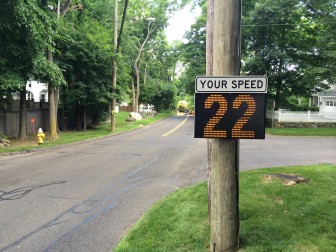Town officials are collecting data on cars’ speeds on Parade Hill Road and plan to enforce selectively the 25 mph limit there after residents said that pedestrians, bicyclists and drivers are at risk because trucks and other motorists travel and take blind turns too fast.
Parade Hill is a popular cut-through between Routes 124 (Oenoke Ridge Road) and 123, including for commercial traffic on Interstate 95. Residents this spring petitioned the town to slow down the vehicles that use it.

After residents requested traffic-calming on Parade Hill Road, town officials set out to collect data and do what they could to ensure safety. In addition to selected enforcement, officials from the Traffic Calming Work Group set up this speed sentry which tells motorists how fast they’re traveling and collects data on their speeds. Credit: Michael Dinan
On Tuesday, members of the Traffic Calming Work Group agreed to put up speed sentries and, with hard data in hand, selectively enforce the 25 mph speed limit there.
Parade Hill Road resident Mary Maechling said vehicular traffic seems to be getting increasingly fast, especially on weekdays, and that she sees many near-misses up near a blind curve toward the top of the road.
“That bend at the top of the hill is one of the more dangerous curves in the road and people take it at at least 25 miles an hour, sometimes more, and they often don’t correct themselves when they come around the bend, so they completely cross over the line,” Maechling said at the work group’s meeting, held in the training room of the New Canaan Police Department.
The work group fields requests for traffic-calming. It includes members of the Department of Public Works, police, fire and Jim Cole, a former police commissioner who now serves on the board of CERT.
“It’s scary,” Maechling said. “The makeup of the neighborhood is changing quite a bit, and there are a lot of young families on the road, and at least 10 bus stops on the road.”
Police Capt. John DiFederico said that though it would be difficult toward the top of Parade Hill, a narrow road, for an officer to find a good spot to tuck in for speed enforcement, they would try to find some place toward the bottom of the hill.
DiFederico, Cole, DPW Assistant Director Tiger Mann and Fire Chief Jack Hennessey fielded questions from the residents, including some suggestions on how traffic may be slowed:
- Changing speed limit to 15 mph—It’s not possible to change the speed limit by 10 mph (it’s 25 currently), though yellow advisory signs recommending a slower speed are possible.
- Sidewalks—Parade Hill Road is on a working list of sidewalk projects (since it would connect Oenoke Ridge to Forest) but the challenge is finding funding for it. It’s especially expensive on a road like Parade Hill with elevated property on either side of the road, which makes retaining walls necessary.
- Four-way stop at Parade Hill and Rural Drive: Motorists would not expect to find a stop sign there so they likely would run it, risking injury to pedestrians who cross the road and feel protected by the stop sign (as on Seminary at Oenoke Lane now).
- No thru-truck zone: The state likely would reject such a proposal because it effectively would mean trucks would need either to get up from 123 to 124 by way of Locust Avenue, Heritage Hill Road or somewhere outside of New Canaan entirely.
Siwanoy Road resident Shannon Goetz asked whether installing speed bumps were a possibility.
Mann said that if Parade Hill is an emergency road then speed bumps would not be allowed, and in any case that a lot of new curbing and signage is needed in order to get speed bumps in, which could change the road dramatically.
“If you look at the total installation of what it would be, it changes the nature of the road to something you might not want,” Mann said. “It would definitely change the aesthetics into something that’s not as appealing as you may think it would be.”